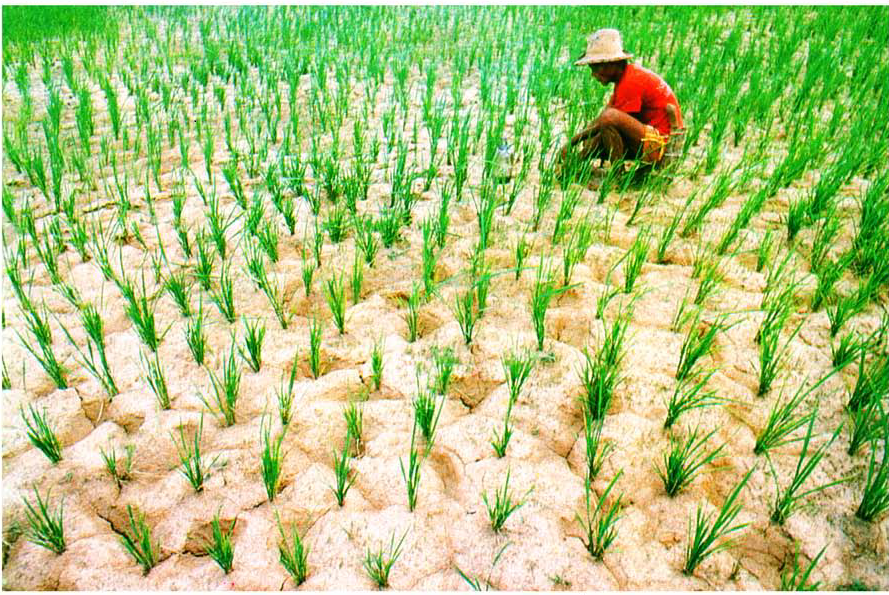The CGIAR study showed striking increases in rice production as a result of the collaboration between IRRI and national agricultural systems. Farmers grow high yielding rice varieties on 70 million hectares—about 55% of the rice land in developing countries. The yield increase contribution of modern varieties alone, not considering their catalytic role in encouraging other inputs that increase yield, is about one-half ton per hectare. That 35 million tons of additional rice per year feeds one-third of a billion people. We are more than ever convinced that the proven model of purposeful cooperation between international centers and national programs is the pathway to enduring agricultural progress.

IRRI is working to develop varieties and management practices for farmers who toil in harsh economic and physical environments. (Photo: IRRI)
.
The year 1985 was one of self-examination for IRRI. We reviewed progress and set guidelines for future research, training, and national program collaboration in a series of scientific meetings during our 25th anniversary.
 The impact of the international agricultural research centers was assessed by the Consultative Group on International Agricultural Research (CGIAR). And the Technical Advisory Committee (TAC) set new and expanded priorities.
The impact of the international agricultural research centers was assessed by the Consultative Group on International Agricultural Research (CGIAR). And the Technical Advisory Committee (TAC) set new and expanded priorities.
The CGIAR study showed striking increases in rice production as a result of collaboration between IRRI and national agricultural systems. Farmers grow high yielding rice varieties on 70 million hectares—about 55% of the rice land in developing countries. The yield increase contribution of modern varieties alone, not considering their catalytic role in encouraging other inputs that increase yield, is about one-half ton per hectare. That 35 million tons of additional rice per year feeds one-third of a billion people.
India and Indonesia, countries that once faced widespread food shortages themselves, contributed 100,000 tons of wheat and rice, respectively, to drought-stricken countries of Africa in 1985.
The 25th-anniversary symposium Rice Research: Accomplishments and Challenges gathered ministers of agriculture and policymakers who decide the key issues of resource allocation for R&D, agricultural scientists, and farmers. They largely supported the conclusions of the impact study:
“…IRRI actively supported and assisted in establishing the China National Rice Research Institute…” He Kang, Minister of Agriculture, Animal Husbandry, and Fishery, China.
“IRRI, in particular, has been very important to us, especially in its association with the Thai Rice Research Institute…” Barom Tanthien, Deputy Minister of Agriculture and Cooperatives, Thailand.
“… for the first time in (Madagascar)… a national program for rice research has been established… implemented by a multidisciplinary team including two IRRI researchers… ” Rabesa Zafera Antoine, Minister of Scientific and Technological Research for Development, Madagascar.
But another message was also clear: that much more work remains.
Let us also ask IRRI to continue its services for the benefit of our countries.” A. Affandi, Minister of Agriculture, Indonesia.
“Toward the realization of national mandate(s). .. and the international mandate of IRRI, there should be greater and more effective collaboration.” Buta Singh, Minister of Agriculture and Rural Development, India.
IRRI’s first trainees, all degree scholars, arrived in 1962; the first group of short-term trainees came in 1964. By 1985, more than 3,700 rice workers had participated in IRRI training. Fully one-third of them were degree scholars, many of whom are continuing careers in rice research while some are now research administrators and agricultural policymakers in national programs. A TAC report on training in the CGIAR system commended IRRI’s programs and recommended that individual countries take responsibility for some training while IRRI develops new courses and phase out older ones.
We are implementing those recommendations. Last year we offered eight new courses and cooperated with Bhutan and Burma to develop trainers and course materials for local rice production courses.
Appropriate technology for harsher physical and economic conditions is more difficult to develop and disseminate than the earlier technology developed for areas favored by well-controlled water, fertile soils, and other factors suitable for high production. The TAC priorities paper called for greater research emphasis on solutions to the economic and environmental problems faced by farmers in less-favored areas.
The most urgent needs are the development of rice varieties and management practices for farmers in economically and environmentally disadvantaged areas, those bound to rainfed upland and lowland rice areas, deepwater rice areas, or problem soil areas. At the same time, we must continue to develop, for farmers in more favored irrigated areas, low-cost smallholder-friendly technologies to permit them to reduce production cost without sacrificing yield gains already made.
In this report, we emphasize our efforts to develop rices for harsh environments and adverse soils. These rices, too, must have strong and stable insect and disease resistance. Germplasm collection and management and basic research to increase yield potential are integral components of these efforts.
In agronomic management we emphasize special technologies for problem soils, increasing fertilizer efficiency, using biological nitrogen fixation and biofertilizers to reduce mineral nitrogen requirements, and tillage practices and implements to conserve energy and maximize crop production.
We seek to develop methods for maximizing water use efficiency by reducing irrigation and improving flood control.
Synthetic insecticides are expensive and may be dangerous if mishandled. Our pest management program emphasizes the integration of disease- and insect-resistant rice varieties, need-based chemical controls, methods to encourage natural enemies of pests, botanical insecticides, and simple pest monitoring procedures.
In the farming systems program, we try to integrate all facets of IRRI rice research with research on other crops conducted by national institutions and international centers. For economically disadvantaged farmers in adverse environments, sustainable, stable high yields are particularly important.
We have benefited from our year of self-examination with the help of national scientists, policymakers, and donors, as well as that of farmers, who are the ultimate judges of our work. Their commendations gave us hope. Their in-depth reviews gave us the insight to focus more sharply on the urgent work ahead.
We are more than ever convinced that the proven model of purposeful cooperation between international centers and national programs is the pathway to enduring agricultural progress.







